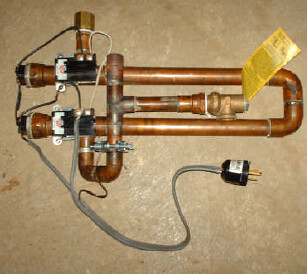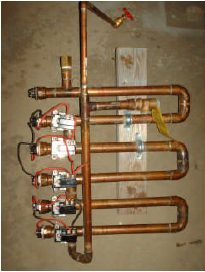unique solar application
Comments
-
Re: unique solar applicationThe fact that switching DC is a problem is very true , but I have solutions for that. Useing the thermostat to switch an oversized DC rated contactor.
Latching contactor or does the magnet draw power continuously? How much does it draw? -
Re: unique solar application
keith - Here is another idea
I was searching google for more information on Solar, heating etc and came across a thread on a motor home forum on DIY Instant hot water plans.
http://repairingyesterdaystrailers.yuku.com/topic/1022/DIY-Instant-Hot-Water-Heater-Plans?page=1
Instead of using AC elements what about using DC elements connected to the dump load. Connect the device to a second pre-heater tank and have a slow DC pump cycle the water through the heating elements while the excess solar energy is heating the water and driving the pump.
or this expanded version depending on how much excess you have
added to
http://www.teladaq.com/heliatos/ayb/connectionSchemes.htm
I found an inexpensive high temp low flow pump on lightobject.com and there are others there.
Specification
Input: DC 5~6V
Output: 1.0L/min or 0.264 gallon/min
Range: 1M (3ft horizon) @6V
Current: 300mA@6V
Intake: 9mm Dia.
Outlet: 7mm Dia.
Life span: > 20,000hrs @ 1600rpm~4200rpm
Noise: << 20dB
Working Temp: 100'C (non-submersed)
Size(L*W*D): 32mmx22mmx36mm (1.26" X 0.87" X 1.42")
Weight (net): 2.0oz
Just a thought from a rookie -
Re: unique solar application
Technical point: there's really no such thing as a DC heating element. It's just a piece of resistance wire. It doesn't care if the current flows in one direction or both. The same can't be said for controls such as thermostats, however. Any element will have a Watt rating which will translate into the amount of heat you can get out of it. That is based on a given supply Voltage and current draw (reflective of the resistance value). Lower the Voltage (is in a DC system) and you get less Watts and less heat.
Beware of the use of a term like "DC water heating element" as an excuse to charge high prices for the same thing. -
Re: unique solar applicationCariboocoot wrote: »Technical point: there's really no such thing as a DC heating element. It's just a piece of resistance wire. It doesn't care if the current flows in one direction or both. The same can't be said for controls such as thermostats, however. Any element will have a Watt rating which will translate into the amount of heat you can get out of it. That is based on a given supply Voltage and current draw (reflective of the resistance value). Lower the Voltage (is in a DC system) and you get less Watts and less heat.
Beware of the use of a term like "DC water heating element" as an excuse to charge high prices for the same thing.
coot,
you are correct in your analogy, but would you put a 240vac heating element to use with say a 24v source? of course not as it wouldn't heat. now using a 24vac heating element with 24vdc would work. ac or dc as you said does not matter, but being a resistance the voltage does matter. -
Re: unique solar application
Basically, to estimate the power of a higher voltage element at low voltage:- Power = (Element Watts at Vac rating) * (Vbatt)*2 / (Vac rating)*2
- Power = 4,800 watts * 24v^2 / 240v^2 = 48 watts
Note: Nichrome wire resistance is sensitive to temperature... As the wire cools, its resistance drops--So it is very possible that the above "48 watt" DC element will draw significantly more power because the element runs cooler on 24 VDC... Do your own measurements to confirm.Near San Francisco California: 3.5kWatt Grid Tied Solar power system+small backup genset
Categories
- All Categories
- 233 Forum & Website
- 141 Solar Forum News and Announcements
- 1.4K Solar News, Reviews, & Product Announcements
- 199 Solar Information links & sources, event announcements
- 900 Solar Product Reviews & Opinions
- 256 Solar Skeptics, Hype, & Scams Corner
- 22.5K Solar Electric Power, Wind Power & Balance of System
- 3.5K General Solar Power Topics
- 6.7K Solar Beginners Corner
- 1K PV Installers Forum - NEC, Wiring, Installation
- 2.1K Advanced Solar Electric Technical Forum
- 5.6K Off Grid Solar & Battery Systems
- 429 Caravan, Recreational Vehicle, and Marine Power Systems
- 1.1K Grid Tie and Grid Interactive Systems
- 656 Solar Water Pumping
- 816 Wind Power Generation
- 624 Energy Use & Conservation
- 623 Discussion Forums/Café
- 315 In the Weeds--Member's Choice
- 75 Construction
- 125 New Battery Technologies
- 108 Old Battery Tech Discussions
- 3.8K Solar News - Automatic Feed
- 3.8K Solar Energy News RSS Feed
